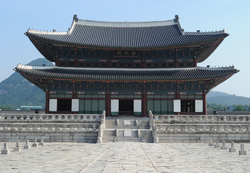History
| History of Korea |
|---|
 |
| Timeline |
The Yemaek are believed to be the mix of the Ye (濊) and Maek (貊) people. [7] He Qiutao (何秋涛) believes Ye is the short name of Buyeo. [8]
According to Chinese Records of Three Kingdoms, the Ye worshiped tigers. [9] The Chinese characters 貊 and 貉, which were used to transcribe Maek, were also used as a homophonic phonetic loan character to write 貘, meaning "white leopard"; [10] however, Guo Pu believes 貘 means a kind of bear, [11] now identified as the giant panda. [12]
Gomnaru, the capital of the Baekje Kingdom with ancestral ties to the Yemaek, means "bear port". Historians suggest tigers and bears may have been totems worshiped by Ye and Maek tribes. The Chinese character 狛, a variant form 貊 for Maek, is used in the Japanese language to transcribe Koma (cf. Komainu). Koma is sometimes written with the characters 高麗 "Go(gu)ryeo, Goryeo." The similarity between the pronunciation of Koma (bear) and gōm (bear) is notable.
A recent study believes the ancestor of Maek (貊) is the Bal (發). According to Records of the Grand Historian, the Balhae people lived next to the Shanrong nomads and the Sushen. According to Guanzi, the Bal-Joseons once sold patterned fur skins and visited the Royal Court. Written in the Yi Zhou Shu, there are the Ye and Bal, but no Maek. Due to this, it is believed Balhae people and Gojoseon may have lived in adjacent areas. [13] [14] [15] [16] [17]
The main culture is the Seodansan culture. Korean historians believe the Yemaek established their cultural zone in the 12th to 10th century BC. These tribes began to grow more heterogeneously by the 7th and 8th centuries BC due to different geographical and environmental circumstances. [18] The Yemaek are believed influenced by the Mongol-Siberian nomadic cultures and that their ethnic origins were distinct from those of the Han Chinese. [19] By the late Bronze Age and Early Iron Age, the Yemaek were technologically and culturally influenced by ancient Han Chinese who introduced ironmaking technology to them. [20]
In 705 BC, the Shanrong nomads (山戎) planned to plunder the Yan, Qi and Zhao kingdoms in the Guzhu text(孤竹國). However, these nomads were defeated by the allied Yan and Qi (660 BC) and were pushed north. There were many northern peoples within the Shanrong Alliance for plunder, one of them is believed to be the Bal (發). [21] After the Gojoseon–Yan War and Han conquest of Gojoseon, the Bal people (發) moved east and became absorbed into the Maek tribe.
It is believed the Gojoseon, the first Korean kingdom in history, was established by the Yemaek. [22]
- According to Chinese record Shiji, to the east of the Xiongnu people lived the Yemaek and Gojoseon. [23]
- Tombstone of Yŏn Namsan found in Luoyang writes that the son of Goguryeo leader Yŏn Kaesomun is Joseon. [24] [ clarification needed ]
- In Dangun's legend of the creation of Gojoseon, a tiger and bear pray to Hwanung that they may become human but promised to stay in a cave eating only garlic and mugwort, however, while the tiger gave up and left the cave, the bear remained and in 21 days transformed into a woman who later married Hwanung. She then gave birth to Dangun Wanggeom, [25] who is believed to symbolize the combination of Ye and Maek tribes into one Yemaek tribe. [26]
Japanese researcher Shiratori Kurakichi is the first to connect between Yemaek tribal people and the origins of the "Korean race." He believed that Korean racial origins can be traced to Manchuria and treated the Ye and the Yemaek as a single racial entity. However, Pai argues that the Ye or Maek could not have referred to a homogeneous tribe or racial unity, or a unified state. [27] Chinese records were inconsistent and frequently mentions Ye without any connections to Maek.